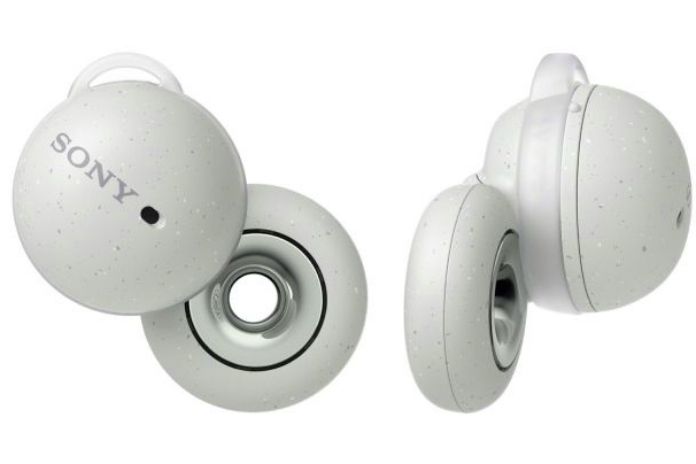With the Link Buds, Sony has introduced new Bluetooth earplugs designed significantly differently from conventional earplugs. The devices look like two interlocked rings. Unlike many competing products, the Sony plugs do not go into the ear canal but are hooked into the auricle.
The plugs are clamped between the cartilage mass in front of the auricle, the tragus, and the ear bulge, which happens without any significant pressure. The plugs are hanging between these ear areas. Wearing comfort is very comfortable with us, free of pain, nothing presses, and soon we forget that we were wearing them at all.
Unlike conventional earplugs, the Link Buds do not have attachments but instead rings with plastic tabs of different sizes to fix the plugs to the ear bulge. There are rings in five sizes for different ear shapes. Sony states that many different ear shapes were measured for all customers to ensure an optimal fit.
The Link Buds And The Many Ear Shapes
But if you have a rather large ear canal or a very small ear canal, you will run into problems: If the ear canal is vast, the Link Buds slip into the ear and no longer touch the ear bulge. Then they are not helpful because they are not held and can fall out of the ear with slight movements. If the auricle is very small, there is insufficient space between the tragus and the ear ridge to fix the plugs. Then they sit too loosely in the ear and easily fall out. Even with the Sony newcomers, the typical problem with earplugs remains that they don’t all fit well without exception.
They will hold up well if the Link Buds fit in your ear. This also applies when wearing it under a hat. However, they are only suitable for wearing hats to a limited extent: annoying scraping and scratching noises can be heard when we move our heads. The Sony plugs are certified according to IPX4 and are therefore protected against splash water. With the Link Buds, Sony does precisely the opposite of earplugs with active or passive noise reduction: They deliberately let ambient noise into the ear. If you don’t want that, you won’t be happy with the Sony newcomers. It’s a similar approach to Sony’s SRS-NB10 neckband speaker. However, while this is primarily designed for indoor use, the Link Buds can also be used very well outdoors.
Link Buds Are Ideal For Home Office Use
The Sony plugs are ideal for use in the home office: the front doorbell can always be heard during telephone calls or business video conferences, for example, because all noises from the environment still penetrate the ear. Even those who listen to music don’t have to worry about missing essential parcel deliveries. With Link Buds in our ears, we can talk to others without turning on a transparency mode first. With classic earplugs, no conversation would be possible in a comparable situation without the transparency mode.
Link Buds With Excellent Microphone Performance Are Not Sensitive To Wind
We liked the Sony newcomers when used outdoors. Many competing earplugs have big problems when it’s a bit windy. Then whistling wind noise significantly disrupts the enjoyment of music. With the Link Buds, there is no such whistling noise in the plug, even when the wind is blowing in our ears. When making phone calls, the Sony plugs do an excellent job suppressing ambient noise. Despite the wind or passing cars, we can easily understand conversation partners. Annoyingly, we cannot switch the microphones on or off with the plug during a call.
Due to the open design, we hear road traffic noises well when listening to music. However, Sony has come up with something so that the music can always be heard well. The plugs can be set to adjust the volume depending on the ambient noise level automatically. The music gets louder if we’re walking down a quiet street and a car drives by. If the car is gone, the original volume is set again. This works very well, and the volume is increased or decreased pleasantly slowly.
Also Read: Paying Contactless Is Even Easier With The iPhone

